Spray atomization of multi-swirl injector for port fuel injection engine
 |
 |
 |
 |
| Kazuki YOSHIMURA Hitachi, Ltd. |
Yoshihito YASUKAWA Hitachi, Ltd. |
Eiji ISHII Hitachi, Ltd. |
Nobuaki KOBAYASHI Hitachi Automotive Systems, Ltd. |
Abstract
We have studied the spray atomization of a multi-swirl injector with three orifices. Hollow-cone spray interactions and the flow field inside the nozzle were investigated by experimental observations and numerical simulations. First, the effects of the spray interactions on the spray atomization were investigated by optically measuring the spray patterns and the Sauter mean diameter (SMD) using the laser diffraction. The spray patterns indicated that the sprays from each orifice interact under the orifices, and this interaction can be classified into two types: liquid-film collision and droplet collision. In the case of the liquid-film collision, the collided liquid films are supposed to merge and then break up into larger droplets. In comparison, droplet collisions have a small effect on the value of the SMD in our experiments. Second, numerical simulations were conducted to investigate the flow field inside the orifices. The simulation results showed that a liquid film was formed along the side wall of the orifice, and the liquid film of the three orifices was thinner than that of the single orifice. From the experiments conducted above, smaller SMD was measured in the case of three orifices with droplet collision. These facts imply that the droplet diameter is decreased in the case of the three orifices. Finally, we proposed a modified atomization model to calculate the mean droplet diameter of the hollow-cone spray from the film thickness and velocity at an orifice outlet. The film thickness and velocity were calculated by the internal nozzle flow simulation. Although the modified atomization model underestimates the SMD under the liquid-film collision condition, it agrees well with the measured SMD under the droplet collision condition.
Keywords
Atomization, Gas-liquid two-phase flow, Injector, Numerical simulation, Swirling flow
Figures

Fig. 1 Schematics of multi-swirl injector. (a) Nozzle plate with three swirl chambers and orifices. (b) Section A-A of injector tip. The fuel is sprayed from the orifice, and hollow cone sprays interact with each other under the orifices.
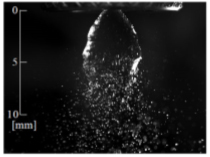 |
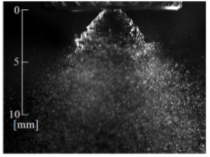 |
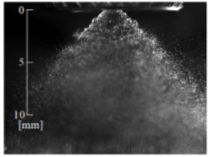 |
| ΔPinj = 100 kPa | ΔPinj = 300 kPa | ΔPinj = 900 kPa |
| Fig. 2 Images of spray from injector with the single orifice taken by long-distance microscope. The liquid film is formed under the nozzle and broke up into droplets. The liquid film length is shortened as the injection pressure increased. | ||
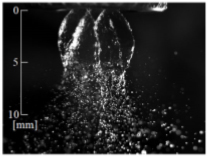 |
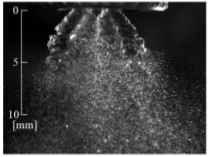 |
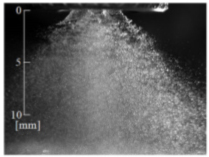 |
| ΔPinj = 100 kPa | ΔPinj = 300 kPa | ΔPinj = 900 kPa |
| Fig. 3 Images of spray from injector with the three orifices taken by long-distance microscope. The spray from each orifice interacts in every condition of injection pressure. In particular, liquid film collisions are seen at 100 kPa and 300 kPa. | ||

Fig. 4 Measured SMD as a function of injection pressure. The results show that the values of the three orifices are higher than those of the single orifice at a low injection pressure condition. It is considered that the SMD is related to spray interaction.
 |
| Fig. 5 Analysis models with (a) the single orifice and (b) the three orifices. The total number of cells is (a) 0.47 million and (b) 1.39 million. |

Fig. 6 Visualization of velocity vectors and gas-liquid interface near the orifice with (a) the single orifice, (b) section B-B, and (c) the three orifices. Air penetrates into the swirl chamber because of the pressure drop caused by swirling flow in the nozzle.

Fig. 7 Comparison of measured SMD and calculated mean droplet diameter in (a) a single orifice and (b) three orifices. The calculated SMD are in good agreement with the measured one of the single orifice. However, the results of the three orifices have a gap from measurements at a low injection pressure condition because liquid film collision is not modeled in our study.

